
One of the cooler things about building renovations is that sometimes they uncover pieces of history, such as old plaques or advertising signs. Such was the case with the building being converted into residences next to the Webster Avenue Stage in Memphis’ River Arts Fest. I had been standing beside it for a couple of hours or so, and hadn’t noticed anything about it, but when the afternoon sun hit it a certain way, I could clearly make out an old sign: “Chero-Cola Bottling Company.” What on earth was Chero-Cola, I wondered? As it turns out, Chero-Cola, founded by a grocery store owner in Columbus, Georgia in 1915 was the predecessor to the far better-known Royal Crown Cola, or RC, the beverage that went with a moon pie in the Southern past. The founder was trying to find a replacement for Atlanta-based Coca Cola when the Columbus distributor for the latter refused to give him a volume discount he felt he deserved. Although the first Royal Crown beverages appeared earlier (a ginger ale and a root beer), Chero-Cola (did it perhaps include cherry flavoring in the formula?) first appeared in 1915, and only lasted through about 1921, when a court ruled that the designation “cola” could only be used by Chero-Cola’s famous competitor, Coke. Without being able to designate their signature drink as a cola, sales flagged, and the company was renamed from Chero-Cola to Nehi. By the time it introduced a new cola formula in 1933, the name had been changed again to Royal Crown or RC. A court in 1944 overturned the old 1921 decision, and RC’s became officially “colas” again. But the coolest thing is that the relatively-short time that Chero-Cola existed helps us place the Memphis building in time between the years 1915 and 1921. A really cool discovery indeed!
History
America’s Golden Age Revived with the Side Street Steppers @SideStSteppers
americana, Blues, entertainment, events, folk, History, jazz, music, musicologyThe Side Street Steppers are a Memphis-based band whose repertoire consists mainly of music from the 1920’s and 1930’s, an era that has largely been forgotten. It is significant that Memphis’ first recording industry occurred during those years, in which record companies from the north rented rooms at the Peabody Hotel and recorded Black bluesmen and gospel choirs, country string bands and hillbilly musicians. This activity in Memphis continued until the Great Depression put a stop to the early independent record labels. Much of this kind of music finds its way into Side Street Steppers shows, and they are both accomplished musicians and fun to hear.
Keep up with the Side Street Steppers:
http://www.sidestreetsteppers.com
https://www.facebook.com/SideStreetSteppers
https://twitter.com/SideStSteppers
http://instagram.com/msveravictoria
Holly Grove and the 17th Ward of New Orleans
Bounce Music, entertainment, Hip Hop, History, music, musicology, Night Clubs, rap


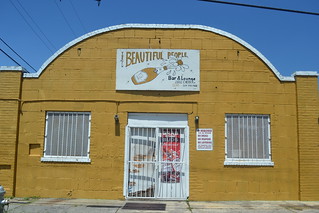





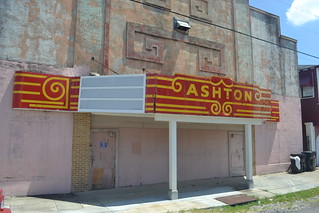


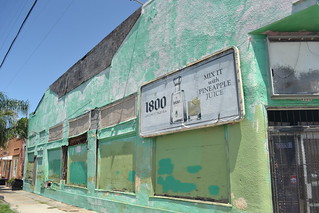
Holly Grove (or Hollygrove) is a neighborhood of New Orleans to the west of the intersection of Earhart Boulevard and Carrollton Avenue, in the historic 17th Ward of New Orleans. It’s not a neighborhood I knew much about, aside from mentions in New Orleans rap songs, so after breakfast at Riccobono’s Panola Street Cafe, I headed into the area to see what I could see. Like many other neighborhoods of New Orleans, the main thing I noticed was little neighborhood bars, grills and lounges on street corners. These places are everywhere in New Orleans, and often are headquarters for various social aid and pleasure clubs, or for the gangs of Black Indians that parade during Mardi Gras season. But I also came upon an historic old theatre called the Ashton, and several nearby historic business buildings in need of restoration. Altogether, while most of the houses seem to be in good condition, it appears that commercial buildings in Holly Grove haven’t fared as well.
Mississippi’s Lumber Legacy Preserved at Bogue Chitto
Abandoned, ghost towns, History, Photography, Travel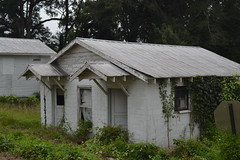





From the end of the 19th Century to the beginning of the 20th, Mississippi began to industrialize, and one of the main industries that emerged was logging. Particularly south of Jackson, the state was covered with virgin forests that were thought to be hundreds of years old, and as the areas was opened up by railroads, cutting that timber became feasible and extremely profitable for the lumber companies that emerged. Most of these firms built company towns, in keeping with the usual practice in the early 20th Century, but by 1929, when the stock market crashed, most of the best timber had already been cut, and since companies in that day did not worry themselves with renewable resources, they had not planted any trees to replace those cut. As a result, most of the sawmills began to shut down, and few of the company towns survived in any great degree. An exception seems to be the sleepy but well-preserved community of Bogue Chitto, Mississippi in Lincoln County, Mississippi (a smaller community with the same name exists in Kemper and Neshoba Counties in North Mississippi). While a community seems to have existed called Bogue Chitto prior to the coming of the railroad and sawmill, the current town with its grid of streets along the railroad likely dates from 1879, the date on the United Methodist Church’s sign. Although nothing of the original business district remains (it was likely along the railroad), the houses and churches, with beautifully ornate architecture and distinctive tin roofs are worth a detour off of I-55. The reason why Bogue Chitto survived the boom-bust cycle of the lumber industry is unclear, as its southern neighbor of Norfield was not nearly so lucky and hardly a trace of the latter town remains. At least part of it may be that Bogue Chitto, unlike must lumber towns, was an incorporated town from 1892 to 1944 and had a municipal government. At any rate, Bogue Chitto is a remarkably well-maintained example of what a Mississippi logging town looked like in the early 20th Century, and should probably be promoted as such to visitors to the state. Of course, perhaps those who live there prefer it to maintain its solitude and quiet.
Highway 51 Revisited: Forgotten Towns in North Mississippi
Abandoned, Architecture, Blues, Education, ghost towns, History, Night Clubs, Photography, Schools, Travel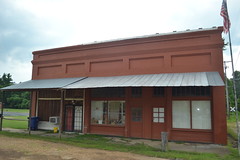




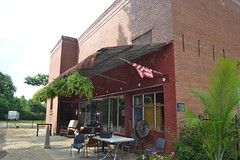






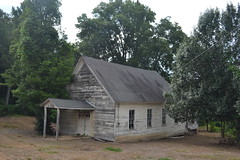





During the 1960’s, the new interstate highways began to bypass the old US highways and the towns along them, and gradually these towns began to fade into obscurity. But a trip along the old highways can be extremely rewarding, revealing ghost towns and historic buildings. On last Friday, August 1, I decided to make my trip to Jackson along Highway 51 from Batesville, and found some interesting and intriguing places. The tiny town of Pope, Mississippi in Panola County, aside from residences, was mainly one street along the railroad with a couple of old historic buildings, one of which had been turned into a restaurant called The Place, that looks as if it might warrant further investigation. But I was especially impressed with the town of Enid, from which Enid Lake draws its name although the lake and the town are in different counties. The town, in Tallahatchie County, seems barely above ghost town status these days, but its only remaining downtown building is now a performance space known as the Enid Music Hall, which features live music on weekends, often blues. On the other side of the railroad tracks was a very old wooden church, which certainly appears to be historic, although there is no historic marker. A sign on the building is rusted, but I could still make out that the building had been the Bethany Baptist Church. A nearby building looks as if it had been a one-room school, or perhaps an education building for the church. Down the road just below the city of Oakland, Mississippi, I came upon a large, abandoned school complex along Highway 51. With no signage there, I had no way of knowing what school it was, but I never fail to see these abandoned schools in Mississippi and Louisiana without being depressed. After all, these are poor states with great educational needs, and to see these taxpayer-funded investments rotting away in the Mississippi sun is not a good look at all.
Sermons on the Mounts in the Crescent City
Black History, History, Photography
Any second-line route is likely to pass by any number of churches, but what I had never noticed until last week was how many of those churches have “Mount” in their names. There is Mount Triumph, Mount Carmel, Mount Olive, and all of this in a city well below sea level! Also of interest to me is the fact that so many of them seem to be the “Second” Mount Carmel, or what have you. “First” churches are fairly common, but the proliferation of “seconds” in New Orleans is interesting and certainly worthy of further study. The popularity of the song “Flee As A Bird to the Mountains” among older brass bands suggests that mountain imagery played a role in early African-American Christianity in New Orleans, for reasons that remain obscure. Of course, a lot of African people came to New Orleans from Haiti after the Haitian revolution, and the mountains there had been a place of refuge from slavery. One wonders if the imagery was spread by former Haitians to other African-Americans, and thus became part of the city’s unique heritage.
What’s Left of Waterford, Mississippi
ghost towns, History, PhotographyWaterford, Mississippi in Marshall County is the nearest town to the North Mississippi Hill Country Picnic, if indeed it can be called a town at all. It was formerly a railroad depot on the Mississippi Central Railroad that ran from Holly Springs to Oxford, and there was, judging from what is left, a sort of main street and business district along the railroad. Like so many Mississippi communities, very little remains, although there is still a post office, a couple of churches and some residences.
A Detour To Ebenezer
History, PhotographyPirate’s Lair: Visiting Lafitte, Louisiana
History, Photography, Restaurants, TravelRemembering Royal Castle Hamburgers
Food, History, RestaurantsUnfortunately, the spread of McDonalds, Burger King, Kentucky Fried Chicken and other fast food chains led to a waning of Royal Castle’s fortunes, and when John Jay Hooker and Performance Systems came along offering to buy Royal Castle, William Singer readily agreed. After all, Performance Systems seemed to be riding high with Minnie Pearl’s and Mahalia Jackson’s chicken restaurants, Minnie Pearl’s Roast Beef restaurants, and they were expanding into child care centers and automobile repair centers. What Singer didn’t know is that Performance Systems was rapidly unraveling, and desperately looking for new sources of revenue, such as a 63-store burger chain that might be the most popular in South Florida. The problem was that Hooker’s company was reporting one-time, non-recurring franchise fees as revenue, which led to massive increases in the stock price, but of course, once the franchise rights in all 50 states had been sold, there was little way to generate continuing income, except by starting a new chain (hence the child care centers and car repair shops). Worse, even though PSI had sold franchise rights to the entire country, most of those restaurants had not been built, much less opened or generating revenue. Of the ones that did open, customers seemed less than thrilled with Minnie Pearl’s Fried Chicken. Royal Castle was troubled when purchased by Performance Systems, but probably could have survived. As it was, the failure of the parent company led to the total collapse of Royal Castle…well, almost. Two locations have survived in Miami, under separate owners. The one I took a picture of at 79th and NW 27th Avenue is the most interesting, as it is owned by an African-American who was one of the first ever to be hired by Royal Castle in the mid-1960’s (one of the uglier parts of Royal Castle history is that Black patrons were not allowed inside, nor were Blacks hired to work there until the Civil Rights Movement). It is somehow fitting that he went from being one of the first Black employees to owning one of the only two remaining Royal Castles in the world. Although I wanted to go inside and eat a breakfast (they’re open 24 hours a day), I had already had plenty to eat, so I headed back to my hotel instead.








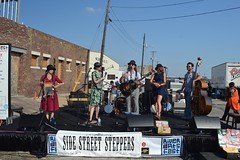



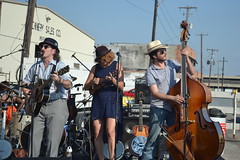



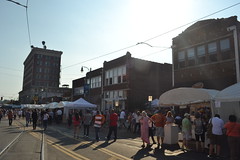

















You must be logged in to post a comment.